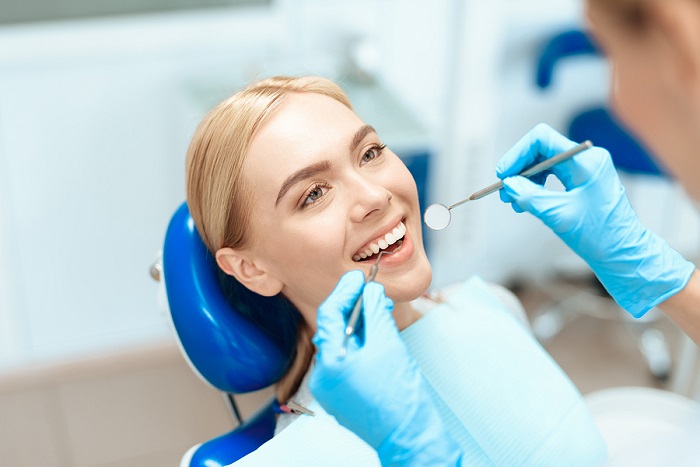Although teeth generally start out as having a pearly white and healthy look, tooth enamel can be many different shades. Moreover, it can change color or become stained, ultimately changing the way you look and feel. While there are options for whitening your teeth for a new and fresh look, not all treatments are as safe or effective as some.
Having whiter teeth is such an important concern, that the booming teeth whitening industry has enabled dazzling smiles within everyone’s reach. From over-the-counter products to professional treatments in a dentist’s office, there are many options for brightening stained or darkened teeth.
Teeth whitening is ideal for people who have healthy, unrestored teeth and gums. Individuals with yellow-toned teeth respond best.
Tooth whitening is not a recommended cosmetic choice for all. If gums have pulled away from the teeth, whitening may irritate these areas. Any tooth decay or gum disease needs to be treated before whitening. Also, tooth whitening cannot change the color of fillings, crowns, and some stains.
Causes of Teeth Discoloration
Over time, teeth can get discolored due to a number of reasons:
Genetics – tooth color can run in the family
Food and Drink – coffee, tea, red wine, some sauces, berries, etc. with intense color pigments called chromogens attach to the tooth enamel.
Tobacco – tar and nicotine create stubborn stains.
Age – over time, the outer enamel thins out and the yellowish dentin layer shows.
Trauma – an injured tooth may change color because it lays down darker dentin.
Medications – certain antihistamines, antibiotics, antipsychotics, and high blood pressure medications, as well as chemotherapy and head/neck radiation can darken teeth.
Fluoride – excess amounts while teeth are developing will also discolor teeth.
How Does Teeth Whitening Work?
Over-the-counter and professional whitening products contain carbamide peroxide or hydrogen peroxide that helps lighten the color deep in the tooth. They get below the surface, break up stains into smaller pieces and lighten tooth enamel.
Teeth “whitening” can be achieved in two ways. Bleaching the tooth so it actually changes the natural color. Bleaching products remove deep (intrinsic) and surface (extrinsic) stains. Non-bleaching whitening products contain agents that work by physical or chemical action to help remove surface stains only.
The tooth whitening business falls into four categories:
- professionally applied in the dentist’s office.
- dentist-prescribed/dispensed for the patient’s home-use.
- purchased/over-the-counter (OTC).
- non-dental settings and options.
Types of Teeth Whitening products
Teeth-whitening options range from gentle surface whiteners to stronger ones that remove deeper stains:
- Toothpastes that remove surface stains.
- Trays filled with whitening product.
- In-office bleaching at a dentist’s.
- At-home bleaching products from a dentist.
- Over-the-counter bleaching products.
- Whitening strips that adhere to and fit the teeth
What are Whitening Strips?
Whitening strips are very thin, virtually invisible strips that are coated with a peroxide-based whitening gel. They are applied to the teeth and adhere to them to work their results. They need to be used over a period of time. Initial results are seen within a few days and last for about four months.
Dangers of Whitening Strips
While whitening strips are relatively safe, just like any OTC treatments, when used unsupervised at home without the knowledge of the dentist, there is an increased chance of serious repercussions. If your teeth become very sensitive or you get sores in your mouth, stop using in-home products and call your dentist.
- Too much whitening can cause severe discomfort to teeth and gums, and can harm tooth enamel if used incorrectly or longer than advised.
- Treatments or kits in non-dental retail settings, such as mall kiosks, salons, spas and, passenger cruise ship are very harmful, as the people administering these treatments are untrained.
- Be wary of toxicity, cellular damage, and carcinogen effects of bleaching on tooth structure, pulp tissue, mucosal tissues and systemic ingestion.
- Mild to moderate tooth sensitivity can occur on hard tissue, due to the peroxide concentration and the contact time, techniques used, and the individual’s response to the treatment methods and materials.
- Gingival (gums) irritation can result from improper contact with peroxide-based gels.
- Existing restorations such as tooth-colored fillings, crowns, bonding, veneers, and bridges do not lighten. Pre-existing dental work may need to be replaced to match the new tooth shade.
- Pregnant women or nursing mothers should not undergo teeth whitening.
Safety Tips
The ADA recommends that whitening treatments or products should only be used after consultation with a dentist, especially for patients with fillings, crowns, and extremely dark stains. A thorough oral examination, to check and treat for tooth and gum health is essential to determine if bleaching is appropriate.
The dentist and patient together can determine the most appropriate treatment. The dentist will advise the patient and supervise the use of bleaching agents and advise on safety precautions.
If you think you are a candidate for teeth whitening or want more information, contact Dr. Ernie Soto at (954) 368-6264.
Office Hours
MON - THU9:00 am - 5:00 pm
FRI9:00 am - 1:00 pm
SAT - SUNClosed
Address: 10187 Cleary Blvd STE 103, Plantation, FL 33324
Email: jenn@drerniesoto.com
Phone: (954) 368-6264





